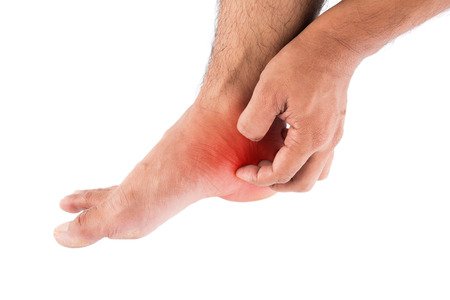Why Your Feet Are Red - Four Possible Causes
Have your recently looked at your feet and noticed they are red? While it may be disconcerting to see your feet red, in most cases, red feet are nothing significant to worry about and can be easily treated. However, sometimes, red feet may be a sign of a more serious condition and that’s when you need to make an appointment with podiatrist Dr. David R. Sullivan. Today, your Westfield Foot and Ankle podiatry team is sharing four reasons why your feet may be red and when the redness may be a sign of a more serious condition and an office visit with Dr. Sullivan.
Allergic Reaction
Allergens like grass or pollen and cosmetic additives found in lotions and soaps can both be triggers for red feet. Other symptoms may include itching, swelling and a rash. For environmental irritants wash and dry your feet promptly to remove any residue. Over-the-counter topical treatments, such as calamine lotion or hydrocortisone can help relieve the itching and swelling. However, if your feet don’t respond to treatment, the symptoms get worse or are accompanied by pain, you’ll want to schedule an appointment with our office.
Infection
Bacteria and fungus can enter through small breaks in the skin and cause an infection. Tell-tale signs of an infection are pain and redness, discharge or an odor and swelling. If you have these symptoms, you are at risk of a worsening infection and need medical assistance. Don’t wait for your symptoms to improve on their own. You’ll want to call our office right away.
Athlete’s foot is a fungal infection that is very contagious. It affects the web of skin between the toes and the soles of the feet. This condition is often picked up in fitness facilities and gyms due to warm, moist environments and community showering. Signs of Athlete’s foot may include redness, burning, itching, peeling between the toes and pain. While there are over-the-counter fungal treatments for athlete’s foot, be sure to contact our office if the condition persists or gets worse. We offer several treatments for Athlete’s foot and the longer you wait, the condition will continue to worsen and potentially spread.
Vascular Conditions
A blood clot, venous insufficiency or peripheral arterial disease can all cause redness in your feet and be a sign that you have an issue with your vascular system which carries blood to and away from your heart.
Blood clots occur when your blood flow decreases. Common causes of blood clots include sitting for long periods of time, immobility or following surgery. Besides redness, signs of clot can include swelling and warmth in the location of the clot. If you think you have a blood clot, Dr. David Sullivan will order a venous Doppler ultrasound and send you directly to the hospital for this noninvasive test which shows any blockage in the veins by a blood clot.
With venous insufficiency, blood in the veins doesn’t flow easily usually because the valves in the veins are damaged causing the blood to flow backward. Common signs of this condition include your feet becoming red over time and painful. While venous insufficiency isn’t a life-threatening condition, it is a progressive disease that can reduce your quality of life.
Peripheral arterial disease (PAD) is caused by your lower extremities not getting enough oxygen. This in turn, causes atherosclerosis – the narrowing of the arteries caused by a buildup of plaque. PAD can cause walking and exercising to be painful. This pain usually shows up when you move and stops when you rest. If you think you’re have symptoms of PAD, you’ll want to schedule an appointment with Dr. Sullivan right away. Early detection of PAD is important so that treatment can start as soon as possible to prevent complications like a heart attack or stroke.
Treatment for vascular issues may include lifestyle changes, medication, tests, nonsurgical treatments and in some cases surgery.
Arthritis
Osteoarthritis is a degenerative disease in which the cartilage in the joints wears away. It is the most common form of arthritis. While anyone can develop arthritis at any time, it usually occurs in individuals over age 65. Besides redness in the feet and ankles, symptoms of osteoarthritis include pain with movement, swelling and tenderness of the affected joints, difficulty putting pressure on your feet and pain or swelling even when at rest.
Imaging technology such as an X-ray may be used to confirm you have arthritis in your feet and ankles. While arthritis is a chronic condition, there are ways to lessen discomfort and prevent further joint damage. Noninvasive treatments include exercising, maintaining a healthy weight, resting, avoiding repetitive movements, physical therapy and MLS Laser Therapy.
Over- the-counter nonsteroidal anti-inflammatory drugs (NSAIDs), such as ibuprofen, can help reduce swelling and relieve pain in foot and ankle joints affected by arthritis. Cortisone shots may also be recommended to help alleviate swelling and pain. Surgery may be necessary in some cases. If you have arthritis, Dr. David Sullivan will put together a treatment plan to help you manage the pain and prevent further joint damage.
If you’re feet are red, don’t panic. Schedule an appointment with podiatrist Dr. David Sullivan serving Westfield, Carmel, Noblesville, Fishers and Zionsville, Ind. He’ll get to the reason for your redness and put together a proper treatment plan that will ease your mind and feet.


